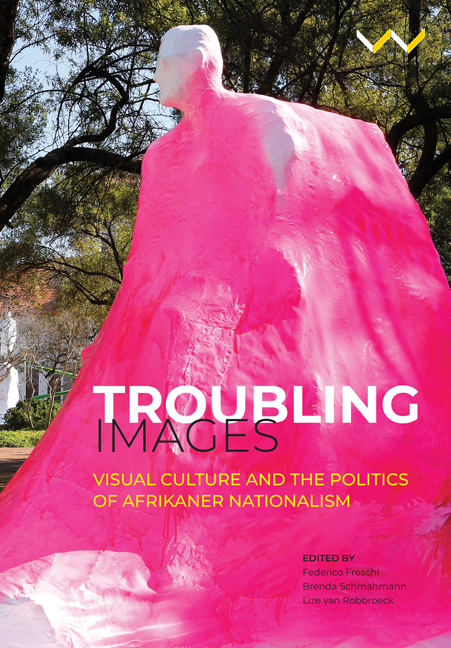Book contents
- Frontmatter
- Contents
- Acknowledgements
- List of Illustrations
- Troubling Images: An Introduction
- 1 The Trajectory and Dynamics of Afrikaner Nationalism in the Twentieth Century: An Overview
- One Assent and Dissent Through Fine Art and Architecture
- Two Sculptures on University Campuses
- Three Photography, Identity and Nationhood
- Four Deploying Mass Media and Popular Visual Culture
- Contributor Biographies
- Index
3 - From Volksargitektuur to Boere Brazil: Afrikaner Nationalism and the Architectural Imaginary of Modernity, 1936–1966
Published online by Cambridge University Press: 21 March 2020
- Frontmatter
- Contents
- Acknowledgements
- List of Illustrations
- Troubling Images: An Introduction
- 1 The Trajectory and Dynamics of Afrikaner Nationalism in the Twentieth Century: An Overview
- One Assent and Dissent Through Fine Art and Architecture
- Two Sculptures on University Campuses
- Three Photography, Identity and Nationhood
- Four Deploying Mass Media and Popular Visual Culture
- Contributor Biographies
- Index
Summary
By the time the National Party came into power in South Africa in 1948, an architectural language associated with Afrikaner nationalism had already been clearly articulated. Informed, on the one hand, by the modernistic, stripped classicism of the 1930s and, on the other, by Cape Dutch and vernacular African traditions, the style that emerged aimed to construct a volksargitektuur [people's architecture] for the maturing Afrikaner nation. As a concrete manifestation of political aspirations at a time when Afrikaner nationalism was asserting its political and cultural dominance, volksargitektuur could make a claim for the authenticity of modern Afrikaners’ uniquely ‘African’ origins and their consequent right to sovereign nationhood.
The quintessential example of volksargitektuur is Gerhard Moerdijk’s1 Voortrekker Monument, which, although conceived during the ideological hothouse of growing Afrikaner nationalist sentiment in the 1930s, was only inaugurated in 1949. Following so close on the heels of the National Party victory, it gave literal expression to the abstractions of politics and nation building, not least in the extent to which its decorative frieze unflinchingly spelled out the racial dynamics of Afrikaner nationalism, with black people being ‘uniformly represented as barbaric savages standing in the way of brave and heroic Boers claiming to bring civilization to the interior in the nineteenth century’ (Grundlingh 2001, 96). The Voortrekker Monument thus not only became the most prominent and celebrated emblem of Afrikaner nationhood, it also appeared to set the tone for future architectural projects of the newly installed Afrikaner nationalist state.
This language had shifted considerably by the time of Verwoerd's assassination in 1966. The symbolic ramifications of this act would soon undermine the nationalistic hubris that had characterised the ascent to power of the infamous ‘Architect of Apartheid’ (Posel 2009; O’Meara 1996); the ramifications presaged, too, the loss of consensus of the nationalist regime evident by the time of the Soweto Uprising of 1976 (Coetzee 1990, 47). On the back of an ever-strengthening economy and burgeoning industrialisation, state-sponsored building projects had proliferated in urban centres throughout the 1960s. Now, however, they were invariably designed in a style that embraced with messianic fervour the concrete-and-glass modernity of post-war New Brutalism (Freschi 2011a, 13). Though largely stripped of applied ornament (if not of sculptural architectonic elements), these state-commissioned buildings generally had decorative programmes that parlayed the blood-and-soil imagery of the 1930s into increasingly abstract forms that promoted new imaginaries of progress and achievement.
- Type
- Chapter
- Information
- Troubling ImagesVisual Culture and the Politics of Afrikaner Nationalism, pp. 66 - 91Publisher: Wits University PressPrint publication year: 2020



